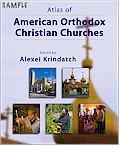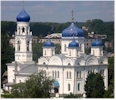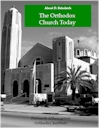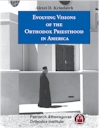Research on Orthodox Christian Communities
in the United States
Alexei D. Krindatch, the National Coordinator for the Second Census of US Orthodox Christian Churches / 2020 US Religion Census.
He can be reached at: Akrindatch@aol.com, 773-551-7226, 510-647-9427
His study reports, maps, and articles on various aspects of the Orthodox Church life in America can be accessed and downloaded here: http://www.assemblyofbishops.org/news/research
Books on Orthodox Christian Churches in the USA:

The first-ever "Atlas of American Orthodox Christian Monasteries" was published in 2016 (first edition) and 2017 (second updated edition). Click on the book cover image for a PDF flyer about the book’s contents. The hard copy of the book is available on Amazon.com
Click on the book cover image for a PDF flyer about the book's contents.
The free PDF version of the Atlas can be downloaded here
Drawing on extensive research, as well as fascinating stories and "insider" anecdotes, the Atlas offers readers:
- A scholarly introduction into traditions of Eastern Christian monasticism and a history of Orthodox monasteries in America,
- A full and comprehensive directory of American Orthodox Christian monasteries,
- An enticing travel guide for those seeking to visit American monasteries and to "sample" monastic life.
In addition, twenty-three selected monasteries share their "personal stories" and offer a glimpse in the surprising spiritual appeal of monastic life in 21st century America.
Edited by Alexei Krindatch. 150 pages of text are accompanied by four sets of color maps and more than one hundred photographs depicting everyday lives of US Orthodox monasteries.

First ever Atlas of American Orthodox Christian Churches was published in 2011. Click on the book cover image for a sample of the book's contents.
The free PDF version of the Atlas can be downloaded here
2015 Facts about Orthodox Christian Churches and Comparisons with other US Congregations
 Fast Questions and Fast Answers about US Orthodox Churches Fast Questions and Fast Answers about US Orthodox Churches
This report provides short and "easy" answers to the following eight questions:
- Geographically, how widespread are the Orthodox Churches throughout the territory of the United States?
- Where are the areas with the strongest Orthodox presence in America?
- What is proportion of the Orthodox Church members in US general population state-by-state and county-by-county?
- Is there anything remarkable about geography of the US Orthodox Churches?
- How large are US Orthodox Churches?
- Are US Orthodox Churches growing?
- How "ethnic" are US Orthodox Churches?
- How good are Orthodox Church members in terms of regularity of church attendance?
The report is accompanied by five county and state level maps.
Map of Orthodox Bishops and Parishes in the United States
This map shows the names, jurisdictional affiliation and locations of all active Orthodox bishops in the United States. The total number of Orthodox parishes in each county is also indicated.
Ten Facts about Geographic Patterns of the Orthodox Church Life in the United States PDF report
This report examines regional differences in Orthodox Church life in the US. It provides detailed information on the total number of church members, parishes, and monasteries in the US; geographic distribution of parishes and church members by state and by county; average parish size by jurisdiction and state; dominance of the different Orthodox jurisdictions in different US states; and growth in the number of Orthodox parishes during the period between 2000 and 2010 state-by-state and county-by-county. In addition, this report offers discussion on the possible regions for the future founding of the new Orthodox parishes. The report is accompanied by six state and county level maps.
Usage of English Language, Ethnic Identity and Ethnic Culture in American Orthodox Christian Churches PDF report
This report is based on the data from a national survey of US Orthodox parishes administered in 2011. Each canonical Orthodox parish in the US was asked to respond to four questions regarding English-language usage during Sunday services and its ethnic culture and identity. 98.6% of parishes participated the survey. In this report, special attention is given to the question of "measuring" the strength of ethnic identity and ethnic culture in various US Orthodox Churches. In addition, the report examines correlation between ethnic identity and English language usage, on the one hand, and regularity of church attendance, on the other hand. Results are presented jurisdiction-by-jurisdiction and also state-by-state. The report is accompanied by four maps.
Eight Facts About Church Attendance in US Orthodox Christian Churches PDF report
This report provides information on regularity of church attendance among US Orthodox Christians overall and by jurisdiction. The report compares total numbers of church adherents versus those who attend church regularly and examines the relationship between parish size and frequency of church attendance. The report also makes state-by-state comparisons and suggests which states might make good “candidates” for new Orthodox parishes. The report is accompanied by three maps.
Holy Toll: The Impact of the 2008-2009 Recession on US Orthodox Christian Churches PDF report
This report examines the budgets and overall financial health of the parishes in three largest American Orthodox jurisdictions: Greek Orthodox Archdiocese of America (GOA), Antiochian Orthodox Christian Archdiocese (AOCA), and Orthodox Church in America (OCA). Special attention is given to the impact of the 2008-2009 economic recession on US Orthodox parishes. The report also compares the recession’s effect on American Orthodox parishes versus Protestant congregations and Roman Catholic parishes. Results are based on a 2010 survey in which 368 GOA, AOCA, and OCA parishes participated.
Five Interesting Facts about Orthodox Church Geography and Demography in the US PDF report
This report summarizes most important information and facts dealing with membership in US Orthodox Churches; regularity of church attendance; geographic distribution of Orthodox parishes; strength of ethnic culture in American Orthodox churches; and Orthodox monastic communities in the US. Data are presented jurisdiction-by-jurisdiction and state-by-state. The report is accompanied by seven maps.
Other Research Reports Available:
 Results of 2010 Census of Orthodox Christian Churches in the USA
The 2010 US Orthodox Census provides information on parishes and monastic communities, on church members and regular attendees in various American Orthodox Christian Churches. Data are available for each local Orthodox parish, each national Orthodox Church and for each geographic area of the United States. Results of 2010 Census of Orthodox Christian Churches in the USA
The 2010 US Orthodox Census provides information on parishes and monastic communities, on church members and regular attendees in various American Orthodox Christian Churches. Data are available for each local Orthodox parish, each national Orthodox Church and for each geographic area of the United States.
 "Orthodox Reality in America" (2010) 8 mb. PPT "Orthodox Reality in America" (2010) 8 mb. PPT
This Power Point presentation discusses many interesting facts about US Orthodox Christian Churches and the American Orthodox community in general. It also presents selected results from the 2010 National Orthodox Census and first findings from the Faith Community Today Study.
"Satisfaction and Morale among Parish Clergy. What American Catholic and Orthodox Priests Can Learn from Each Other." (2006) PDF article
This article describes and compares life and work experiences of the US Orthodox and Roman Catholic Clergy: their major sources of satisfaction and support, the problems that they face and their attitudes towards various aspects of church life.
 “The Orthodox Church Today: a National Study of Parishioners and the Realities of the Orthodox Parish Life in the USA” (2008) “The Orthodox Church Today: a National Study of Parishioners and the Realities of the Orthodox Parish Life in the USA” (2008)
“The Orthodox Church Today” is the first national survey-based study of the laity, ordinary church members, in the two largest Orthodox Churches in the United States: "The Greek Orthodox Archdiocese of America” (GOA) and "The Orthodox Church in America" (OCA). To a significant degree, this study reflects the profile of an entire Orthodox community in the United States.
“The Orthodox Church Today” explored the patterns of everyday life in the local Orthodox parishes. In particular, the study addressed four questions:
- What is the “image” of the Orthodox clergy in the eyes of the ordinary “people in the pews?”
- To what extent do the social and religious attitudes of the ordinary parishioners reflect attitudes and opinions of their parish priests?
- What do church members think about their local parishes?
- What do laity think about various issues dealing with “Democracy and Pluralism in the Church,” “Changes and Innovations in the Church,” and “Religious ‘Particularism’ and Ecumenism?”
Numerous comparisons with the US Roman Catholic and various Protestant Churches make “The Orthodox Church Today” study especially interesting to a wide non-Orthodox audience.
These publications are available in PDF format:
 “Evolving Visions of the Orthodox Priesthood in America” (2006) “Evolving Visions of the Orthodox Priesthood in America” (2006)
This national study of the American Orthodox clergy was conducted in 2006. It was conducted among the parish priests in the Greek Orthodox Metropolises of Chicago and San Francisco and in the Diocese of the West and Midwest of the Orthodox Church in America. The study focused on sources of satisfaction and major challenges in the lives of American Orthodox parish clergy.
The “Evolving Visions of the Orthodox Priesthood in America” also examined clergy attitudes on four subjects that are frequently debated in Church today:
- The Notion and Status of the Priest
- Democracy and Openness in the Church
- Changes and Innovations in the Orthodox Church life
- Ecumenical Attitudes
These publications are available for download in PDF format:

The Orthodox (Eastern Christian) Churches in the USA at The Beginning of a New Millennium (2002)
Research Project Overview
Major Findings and Conclusions
Statistical and Historical Information on Orthodox Churches in the United States (2000):
Methodology of the Orthodox (Eastern Christian) Churches in the USA at The Beginning of a New Millennium study:
This research was sponsored by "Association of Statisticians of American Religious Bodies" as a part of the nationwide "Religious Congregations Membership Study: 2000." The data were obtained directly from the headquarters (diocesan offices) of Orthodox Churches in North America by personal visits there and by interviewing of the church's leaders – the bishops or the chancellors. The major goal of author’s empirical study was creation of a database on all major Orthodox jurisdictions that allow for analysis and comparison of different Orthodox Churches in five major areas:
- Membership: membership "claimed" by Churches versus real number of their adherents, proportions between various demographic sources of their current growth, etc. See the basic results in Table 1a and Table 1b
- Church as religious institution: territorial diocesan organization, institutional composition (parishes, monasteries, and educational institutions), church-based broad religious infrastructure (Sunday- and all-day schools, periodicals). See the basic results in Table 2
- Degree of Church’ integration with wider American society: proportion between English and traditional liturgical languages of the Mother Church, proportion of the mixed "Orthodox – Not Orthodox" marriages, policies towards Anglo-American converts. See the basic results in Table 3
- Ecumenical openness and involvement: membership in interfaith organizations, participation in inter-religious activities. See the basic results in Table 4
- Nonreligious social functions: social institutions affiliated with and administrated by Orthodox Churches, programs of assistance for newly arriving immigrants. See the basic results in Table 5

Other Publications on Orthodox Christian Churches in the USA:
The Power of Micro Theology: How "Liberal," "Moderate," "Traditional" and "Conservation" Eastern Orthodox Priests Shape the Lives of Their Parishes. (2007)
Satisfaction and Morale Among Parish Clergy: What American Catholic and Orthodox Priests Can Learn From Each Other (2006)
The Realities of Orthodox Parish Life in the Western United States: Ten "Simple" Answers to Ten "Not Too Easy" Questions (2005)
“American Orthodoxy” or “Orthodoxy in America”? Profiling the Next Generation of Eastern Christian Clergy in the USA (2004)
Eastern Christianity in North American Religious Landscape: Ethnic Traditionalism Versus Civic Involvement and Social Transformations (2003)
What Makes the Orthodox Churches Strangers to American Mainstream Christianity (2003)
Parish Needs Study (2005)
The Parish Needs Study was administered among the Greek Orthodox, Antiochian Orthodox, Orthodox Church in America and Serbian Orthodox parishes in the western United States. It examined the most urgent ministry issues facing parishes today.
The results can be found in four parts:
Parish Needs Overview
Parish Needs Part 1
Parish Needs Part 2
Parish Needs Part 3
Additional Orthodox Churches Links
Contact Information:
Alexei D. Krindatch, the National Coordinator for the Second Census of US Orthodox Christian Churches / 2020 US Religion Census.
He can be reached at: Akrindatch@aol.com, 1-773-551-7226
|
